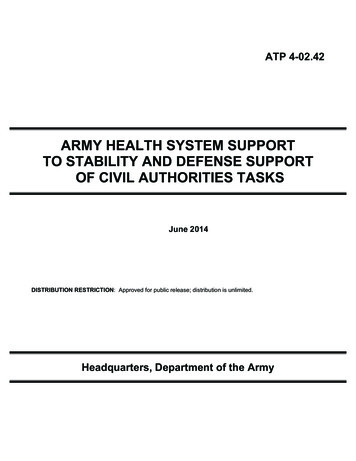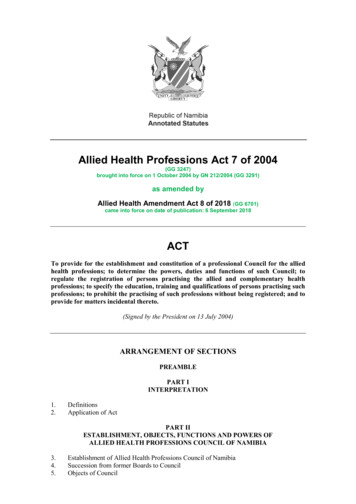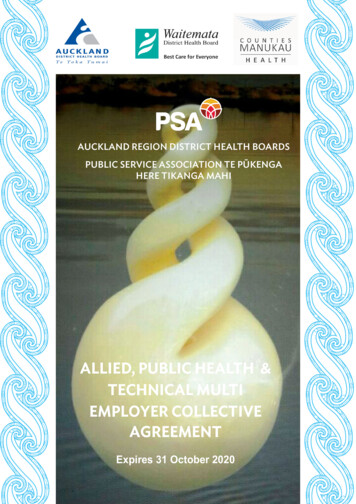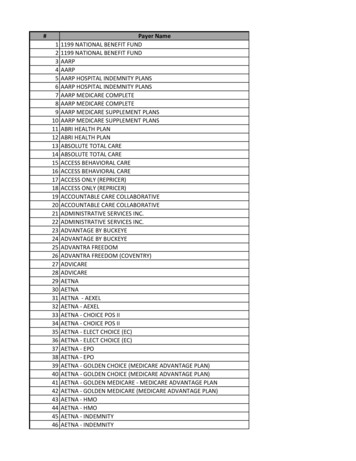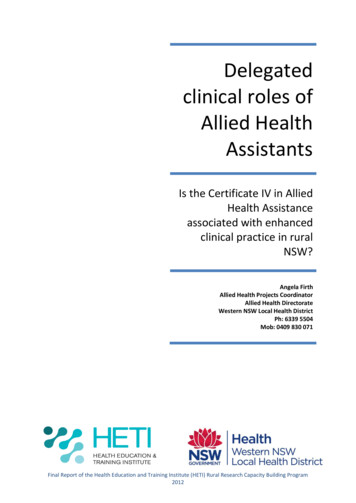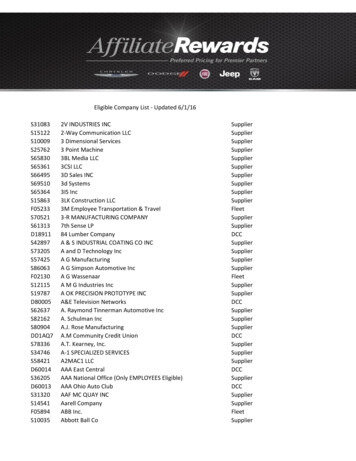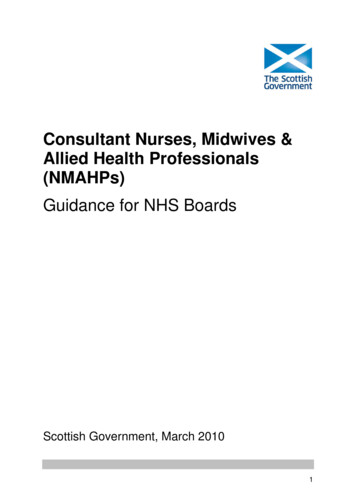
Transcription
Social Assistance and Allied HealthWorkforce Strategy
ABOUT THE STATE TRAINING BOARDThe State Training Board is the peak industry training advisory body to the Minister for Education andTraining in Western Australia. The State Training Board’s functions are set out in Part 3 of theVocational Education and Training Act 1996.The role of the State Training Board is to provide advice to the Minister for Education and Training onthe existing and anticipated supply and demand for skills in various industries, including industries thatare expected to grow or may experience a shortage of skilled labour. The Board’s role is to provideadvice on strategies to support such industries through the vocational education and training (VET)sector.Our members come from a range of industries and are dedicated to training and skills development.The Board provides a direct link between industry and government. We are committed to fosteringstrong partnerships with industry, unions, peak bodies, and employers to identify training and skillsneeded by Western Australian industries for Western Australian jobs.Members of the State Training Board are:Jim Walker (Chair)Vanessa DaviesChris Hall, AMProfessor Cobie RuddMeredith HammatRay SputoreCaptain Angela BondFran KirbyWayne MullerSOCIAL ASSISTANCE AND ALLIED HEALTH WORKFORCE STRATEGYPublished by the State Training Board 2018.This work is copyright. It may be reproduced in whole or in part for study or training purposessubject to an acknowledgement of the source and no commercial use or sale. Reproduction forpurposes other than those above requires written permission of:Office of the State Training BoardDepartment of Training and Workforce DevelopmentLevel 2, 16 Parkland Road, Osborne Park WA 6017Telephone: 08 6551 5593Email: ostb@dtwd.wa.gov.au; Website: stb.wa.gov.auSuggested citation:State Training Board (2018), Social Assistance and Allied Health Workforce Strategy. State TrainingBoard, Government of Western AustraliaDisclaimerThe information in this document has been included in good faith and is based on sources believedto be reliable and accurate at the time the document was developed. While every effort has beenmade to ensure that the information contained within is accurate and up to date, the State TrainingBoard and the State of Western Australia do not accept liability or responsibility for the content ofthe document or for any consequences arising from its use.Social Assistance and Allied Health Workforce Strategy State Training Board2
EXECUTIVE SUMMARYWestern Australia’s community deserves a well-functioning, well-resourced and highly skilledworkforce to support its aged care, disability services, allied health and community services sectors.The demand for these services is expected to increase significantly in the coming years and it isessential that the State implements a plan that secures the workforce needed to meet this demand.The social assistance and allied health sectors have undergone significant reforms in recent years thathave changed the funding, policy and operating environment. The ability for consumers to choose whoprovides their care and support will create a more competitive and innovative market but will presentchallenges and opportunities for the workforce and service providers, such as remuneration, workingconditions, staffing ratios and career pathways.Medical advances and changes in technology and patient carewill require continuous training and skills development. Theseadvancements mean that in order to provide best-practicepatient management and residential care services, workers willbe required to continually update their skills; particularly inareas where boundaries are often challenged, and new areasexplored, such as managing patients with cognitive issues.These factors highlight the importance of providingopportunities for skill development both for existing workersand for new workers joining the industry.The State Training Board established this project to develop an understanding of the workforce andskill needs of the social assistance and allied health sector. The Board established the Social Assistanceand Allied Health Workforce Steering Committee comprising industry peak associations, employers,unions and government agencies to guide the research and the development of an integratedworkforce development plan for the sectors.The Steering Committee’s research has found that the Western Australian social assistance and alliedhealth sectors are undergoing fundamental change driven by new government policy, changingconsumer expectations and an increasingly contestable market. These changes coincide with anescalating demand for services, with the demand for workers predicted to rise across all sectors, ledby the disability and aged care sectors. Significantly, the largest occupational group - support workers– needs to double over the next five years. The short timeline for the rollout of the National DisabilityInsurance Scheme (NDIS) presents an immediate challenge for Western Australia in ensuring anadequately skilled workforce.The vocational education and training (VET) sector must provide training that meets the needs of thesocial assistance and allied health workforce. Understanding the current and future workforcerequirements, including the anticipated growth of the sectors resulting from factors such as the ageingpopulation and the roll out of the NDIS in Western Australia will enable the training system to respondto the demand for training places.Whilst industry is making efforts to meet its workforce skilling commitments with great examples ofinnovation and commitment this appears to be taking place in isolation of the formal VET system.Traineeships are at an all-time low and classroom learning appears to be in decline. Increasedcasualization of the workforce and less than favourable salaries and employment conditions arefurther barriers to the attraction and retention of a skilled workforce.Considering the current environment, it is likely that the Social Assistance and Allied Health sectors willface a challenging future in sustaining a sufficiently skilled workforce.3 State Training BoardSocial Assistance and Allied Health Workforce Strategy
The Steering Committee has identified the opportunity to make changes that will help avert a skillshortage and the risk that inadequately trained workers could present to vulnerable people in thecommunity. In particular, there is strong industry support for the introduction of a “white-card” toensure new workers complete base-level training prior to working with vulnerable people.The cost of VET is a major barrier for students, existing workers and employers in the social assistanceand allied health sector. Financial support to students and employers from the Australian and StateGovernments that fully covers or heavily subsidises the cost of learning could help drive the growth inskilled workers.The State Government should consider lowering course fees, particularly for the Certificate III inIndividual Support and the Certificate III/IV in Allied Health Assistance, to encourage the uptake ofthese critical qualifications and encourage more people to pursue careers in the social assistance andallied health workforce.The State Government and the VET sector will need to consider whether the current funding of trainingplaces is adequate to the meet the growing demand for skilled workers. The State Government’s VETfunding policy must safeguard training opportunities for existing unskilled and semi-skilled workers togain new skills or qualifications needed to care for people with complex needs.While cost is influencing the take-up of training, the Steering Committee has identified otheropportunities to make the VET sector more accessible to both industry and the public. Firstly,streamlining training pathways to provide flexible employment options for students. Secondly,enhancing the quality of training and supporting the regions through a stronger focus on partnershipsbetween TAFE and local employers (similar to the resources sector). The Steering Committee has alsoidentified the opportunity for industry to take a greater leadership role in providing work experienceand placements, particularly for school-aged students.With the State Government and industry working together there is considerable scope to increasecommunity awareness of the career opportunities associated with a VET trained job in and across theSocial Assistance and Allied Health sectors. Significantly, the opportunity already exists within thecurrent training program to equip people with the skills to move across sectors as career aspirationschange. The Inquiry has also identified the opportunity to incorporate a greater focus in schools onawareness of the breadth of career opportunities available across the sectors.There is considerable opportunity to adopt a whole of government approach to the planning c urrentlybeing undertaken to maximise the response to the workforce requirements of the sectors. Furthercollaboration between the Australian and State Government on the implementation of the NDIS is akey part of this work. Government, as a major funder and employer, has considerable scope to driveupskilling of the sectors.The Steering Committee is particularly grateful to Jamie Mackaway and the staff at the CommunityServices, Health and Education Training Council for their research and consultancy work with industryin the development of an integrated workforce development plan.The recommendations presented in this report can be readily implemented given the commitment ofindustry to deliver high quality services and the State Government’s focus on jobs and the opportunitythat the expansion of the Social Assistance and Allied Support sector presents to the WesternAustralian economy. However, further consultations will be required with and between industry andGovernment to develop an implementation plan that establishes a timeframe, targets and budgetnecessary to ensure a timely response.CHRIS HALL, AMCHAIR, SOCIAL ASSISTANCE AND ALLIED HEALTH STEERING COMMITTEESocial Assistance and Allied Health Workforce Strategy State Training Board4
CONTENTSABOUT THE STATE TRAINING BOARD . 2EXECUTIVE SUMMARY . 3CONTENTS . 5List of figures . 7List of tables . 7SOCIAL ASSISTANCE AND ALLIED HEALTH WORKFORCE PROJECT . 8Project Overview . 8Defining “Social Assistance and Allied Health” . 8Terms of Reference . 8Social Assistance and Allied Health Steering Committee . 9RECOMMENDATIONS . 10A coordinated response . 10Workforce development strategies. 10Vocational education and training strategies . 11Future research . 11WORKFORCE DEVELOPMENT PLAN SCOPE . 12A critical and growing industry . 13The demand for services is growing . 14Aged care . 14Disability services . 16Mental health services . 18Allied health services . 19Social assistance services . 20Child care services . 22Services for young people . 22Family support . 23Aboriginal and Torres Strait Islander services . 23Community services support . 24THE WORKFORCE . 25Frontline and service support workers . 26Workforce status . 26Gender profile . 26Age profile . 27Professional and allied health workers . 28Workforce status . 28Gender profile . 28Age profile . 29Management and governance roles. 30Workforce status . 30Gender profile . 30Age profile . 305 State Training BoardSocial Assistance and Allied Health Workforce Strategy
Workforce by industry sector . 31Aged care . 31Disability services . 32Mental health services . 33Allied health services . 33Social assistance services . 34WORKFORCE CHALLENGES. 36Coordinated response to workforce challenges . 36A skilled AND QUALITY workforce . 37Is regulation the answer? . 37STANDARDISED MINIMUM REQUIREMENTS . 38Skills passport . 38Additional funding to support the workforce . 38Regional and remote communities . 39Consumer-directed funding implications for the workforce . 40Equal remuneration order/indexation policy . 42Attraction and retention challenges. 43Recruitment difficulties . 43Attracting a diverse workforce . 45Working conditions and perceptions. 48Mental health of support workers. 50Remuneration and job satisfaction . 50TRAINING DELIVERY . 52Current training delivery . 52Traineeships . 53Qualifications awarded . 55Training pathways . 55Mix of skills needed . 55Essential skills . 56Employer expectations . 57Training curriculum . 57Training quality. 58Support for students . 58Viabilty of enterprise registered training organisations . 59Suitability of training . 59Training affordability . 59WORKFORCE DATA . 61Future workforce requirements . 62Employment forecasts . 62Further research required . 62REFERENCES. 63Social Assistance and Allied Health Workforce Strategy State Training Board6
LIST OF FIGURESFigure 1: A shared responsibility . 10Figure 2: Employment by industry in Western Australia, 2015-16 and 2016-17. 13Figure 3: Western Australia's projected employment growth by industry 2016-17 to 2020-21 . 14Figure 4: Aged care funding by service, Australian Government 2015-16 . 15Figure 5: Social assistance and allied health workforce composition . 25Figure 6: Frontline and service support workers by employment, WA, 2011 and 2016 Census data . 26Figure 7: Frontline and service support workers by gender, WA . 27Figure 8: Frontline and service support workers median age Western Australia, 2016 Census . 27Figure 9: Professional Allied Health Workers by employment, WA, 2016 and 2011 Census . 28Figure 10: Professional and Allied Health workers, by gender, WA . 29Figure 11: Professional and Allied health workers median age, Western Australia 2016 Census . 29Figure 12: Management and Governance roles employment, WA 2011 and 2016 Census . 30Figure 13: Management and Governance roles by gender, Western Australia, 2016 Census . 30Figure 14: Management and Governance roles, median age, Western Australia, 2016 Census . 31Figure 15: Community Services Training Package by occupation, course enrolments, WA 2015 and 2016 . 52Figure 16: Health care training package by occupation, course enrolments, WA 2015 and 2016 . 53Figure 17: Essential skills for working in direct care roles . 56LIST OF TABLESTable 1: Users of aged care in Perth metropolitan area 2009-2017 . 16Table 2: Rollout schedule for nationally delivered NDIS in Western Australia . 18Table 3: Barriers to service access and use by people from CaLD backgrounds . 21Table 4: Australia’s and Western Australia’s progress against the Closing the Gap targets . 23Table 5: Registered health practitioners with WA as principal place of practice, by profession 2016–17 . 33Table 6: Minimum qualification requirements for child care workers . 34Table 7: Early childhood teacher requirements . 34Table 8: Form of employment of the aged care workforce, by occupation 2016 . 49Table 9: Actual hours per week aged care workforce, by occupation 2016 . 49Table 10: Work schedule by occupation 2016 . 49Table 11: Social assistance and allied health traineeships available in Western Australia as at 30 June 2018 . 54Table 12: Frontline and service support workers by employment . 61Table 13: Professional and allied Health Workers by employment . 61Table 14: Management and Governance roles by employment . 627 State Training BoardSocial Assistance and Allied Health Workforce Strategy
SOCIAL ASSISTANCE AND ALLIED HEALTH WORKFORCE PROJECTPROJECT OVERVIEWThe State Training Board initiated this project to understand the workforce needs of WesternAustralia’s Health Care and Social Assistance industry. The Board invited National Disability Services(WA Branch), Aged and Community Services (WA Branch) and WA Council of Social Services to providepresentations in May 2017 on current workforce issues. It became evident that there were commonissues affecting each sub-sector and an agreement that a coordinated approach would be beneficial.In June 2017, the State Training Board resolved to establish a steering committee to inquire into andprovide advice to the Minister for Education and Training. Accordingly, the Board passed a resolutionto establish the steering committee incorporating representatives from Western Australia’s aged care,disability, mental health, allied health and community service sectors (the “sectors”) with a vocationaleducation and training (VET) focus.In September 2017, the State Training Board established the Social Assistance and Allied HealthWorkforce Steering Committee comprising industry, government and non-governmentrepresentatives. The Community Services, Health and Education Training Council were appointed toguide research and consult with industry in the development of an integrated workforce developmentplan for the sectors.DEFINING “SOCIAL ASSISTANCE AND ALLIED HEALTH”For the purposes of this project, it is important to understand what the Steering Committee defines asthe “social assistance and allied health workforce”. The Committee has agreed that the project willinclude the following areas: Aged Care; Disability Ser
Insurance Scheme (NDIS) presents an immediate challenge for Western Australia in ensuring an adequately skilled workforce. The vocational education and training (VET) sector must provide training that meets the needs of the social assistance and allied health workforce. Understanding the current and future workforce


